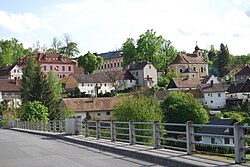Liblín
Market town in Plzeň, Czech Republic From Wikipedia, the free encyclopedia
Market town in Plzeň, Czech Republic From Wikipedia, the free encyclopedia
Liblín is a market town in Rokycany District in the Plzeň Region of the Czech Republic. It has about 300 inhabitants.
Liblín | |
|---|---|
 View from the northeast | |
| Coordinates: 49°55′0″N 13°32′39″E | |
| Country | |
| Region | Plzeň |
| District | Rokycany |
| First mentioned | 1180 |
| Area | |
• Total | 6.05 km2 (2.34 sq mi) |
| Elevation | 312 m (1,024 ft) |
| Population (2024-01-01)[1] | |
• Total | 252 |
| • Density | 42/km2 (110/sq mi) |
| Time zone | UTC+1 (CET) |
| • Summer (DST) | UTC+2 (CEST) |
| Postal code | 331 41 |
| Website | www |
Liblín is located about 19 kilometres (12 mi) north of Rokycany and 22 km (14 mi) northeast of Plzeň. It lies in the Plasy Uplands. The highest point is the hill Na Mýti at 432 m (1,417 ft) above sea level. The municipality is situated on the right bank of the Berounka River; the village is situated in its meander. The Střela River joins the Berounka on the municipal border of Liblín.
The first written mention of Liblín is from 1180. In the second half of the 14th century, the Libštejn Castle was built near Liblín and then was bought by the Kolowrat family. The village became part of the Libštejn estate at the turn of the 14th and 15th centuries. During the Hussite Wars, Liblín was repeatedly damaged and looted. In 1510, the Libštejn estate was acquired by the Waldstein family. At the beginning of the 17th century, the estate was bought by the Gryspek family. During the Thirty Years' War, Liblín was again repeatedly looted. A new period of prosperity began in the 18th century, when a new Baroque castle was built.[2]
In 1904, Liblín was promoted to a market town.[3]
There are no railways or major roads passing through the municipality.

The main landmarks of Liblín are the Liblín Castle and the Church of Saint John of Nepomuk. The castle was built in the late Baroque style in 1721–1725 on the site of an old Renaissance fortress. In 1845, it was modified in the Neoclasical style into its present form. Today it houses an institute of social welfare. The church was built in the castle complex in 1751–1752. Next to the castle is a park with three valuable statues of saints Joseph, Gotthard and John the Evangelist.[6]
A tourist destination is the ruin of the Libštejn Castle. The castle was documented as abandoned in 1590 and definitively fell into disrepair during the Thirty Years' War.[7]
A technical monument is the reinforced concrete arch road bridge that spans over the Berounka. It dates from 1929.[8]
Seamless Wikipedia browsing. On steroids.
Every time you click a link to Wikipedia, Wiktionary or Wikiquote in your browser's search results, it will show the modern Wikiwand interface.
Wikiwand extension is a five stars, simple, with minimum permission required to keep your browsing private, safe and transparent.